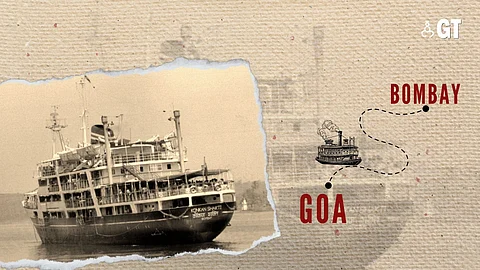

The memories of the past in Goa evoke a sense of longing and wistfulness. The new generation will not be able to fully comprehend certain experiences that the previous generations have gone through, no matter how hard they may attempt to understand.
But for those who’ve have experienced the old times, they have stories to share, and sometimes mere words are not sufficient to depict something that no longer exists today.
If we go back in time, we’d all recollect moments that have been imprinted on our minds. One such memory that the older generation holds dear is the steamer service that operated between Bombay and Goa during the 1960s and 1970s.
Back in those days, the steamer service would leave the Panjim dock at around 10.30 am. And so, hailing from South Goa, Abraham D'Cruz had to hurry to ensure he reached Panjim to board it on time.
Abraham reminisces about his younger days when he would rush inside, get on to the deck of the steamer ship and secure a place by spreading a bedsheet. Those who have sailed on the Konkan Sevak and Konkan Shakti steamers will relate to what Abraham describes.
At the time, the steamers were probably the most economic mode of travel to neighbouring Bombay that many Goans opted for.
At the time, steamers were the most economic mode of travel to neighbouring Bombay and many Goans opted this mode of travel.
On a 24-hour sailing trip to Goa, Abraham, who was then in the eighth standard, remembers bringing home a new BSA bicycle and throughout the entire trip, he carefully cleaned the dust off his cherished new possession.
In December 1967, Marius Fernandes, well-known as festakar (festival organiser), and his family, set off for the UK, he chose the traditional steamer to make it to Bombay.
Reminiscing the days of yore, Marius shares his unforgettable journey saying, “Amidst the bustling ambience of Panjim's Navegação port, my now 92-year-old mum, Anna Fernandes, and her six children, embarked on a steamer voyage – a bygone era filled with excitement, cultural richness and heartfelt connections.”
Like everyone who’d arrived at the harbour, the Fernandes family were enveloped by the typical Goan sights of local vendors peddling their wares, offering the tantalising aroma of Goan sausages, fresh vegetables, all creating a sensory symphony that set the stage for the adventures ahead.
Once aboard, the scene transformed into one of communal camaraderie.
Now 52, Abraham D’Cruz recollects life at the sea as a young passenger in one of these steamers.
He looks back with nostalgia, and remembers casually strolling around the ship, making his way to the farthest point and observing the splashing water below. “It was fun,” he recollects and adds, "Sometimes, the smell of the freshly painted black and white steamer lingered in the air."
Abraham looks back with nostalgia, and remembers casually strolling around the ship, making his way to the farthest point and observing the splashing water below.
Once the ship set sail from the pier, residents would come together for lively card games or some would just involve in casual conversations to pass time. As the evening drew on and night progressed, the atmosphere would be filled with the enchanting tunes of guitars and other traditional musical instruments.
Musicians would serenade fellow passengers with Konkani mandos, creating an atmosphere of joy that transcended the confines of the vessel.
Abraham remembers how a man would move around with a portable funnel to announce a game of Tambola in the evening. He recalls joining his elders on the upper deck to enjoy the cool salty air. "I would always keep an eye on the life-jackets in case of an emergency," he smiles.
The journey to Bombay was punctuated by moments of serenity and excitement, as the steamer made stops to pick up passengers from neighbouring villages in Maharashtra.
Marius Fernandes
The endless sea also offered much to lay your eyes on, right from spotting the tiny forts, majestically set on the shore, to rocky islands with a single lighthouse to plenty of jellyfish.
“The journey to Bombay was punctuated by moments of serenity and excitement, as the steamer made stops to pick up passengers from neighbouring villages in Maharashtra,” says Marius, adding that every encounter added a layer of richness and an opportunity to forge everlasting connections.
As the night wore on, time seemed to slip away, carried along by the rhythmic hum of the steamer's engine.
“In the morning, breakfast would take place on the steamer before reaching Bhaucha Dakka port in Bombay,” Abraham mentions, remembering those startling loud blasts announcing their arrival before reaching the ports.
The TC would then make his rounds up and down, checking the passengers' tickets.
The most fascinating aspect of the 1960s and 1970s was the ability of people to find happiness and appreciate the beauty of everyday life, even with limited resources.
For Abraham D’Cruz and Anna Fernandes and her six kids and many Goans who set sail on such voyages back in the day, the steamers became more than a means of transport, filling it with a warmth of community, they became a testament to the enduring spirit of adventure.